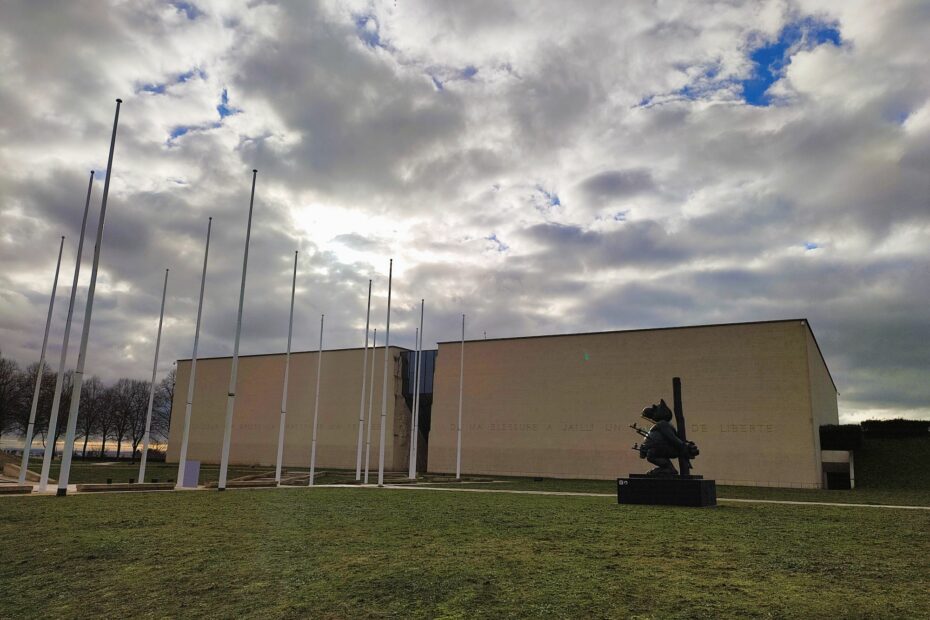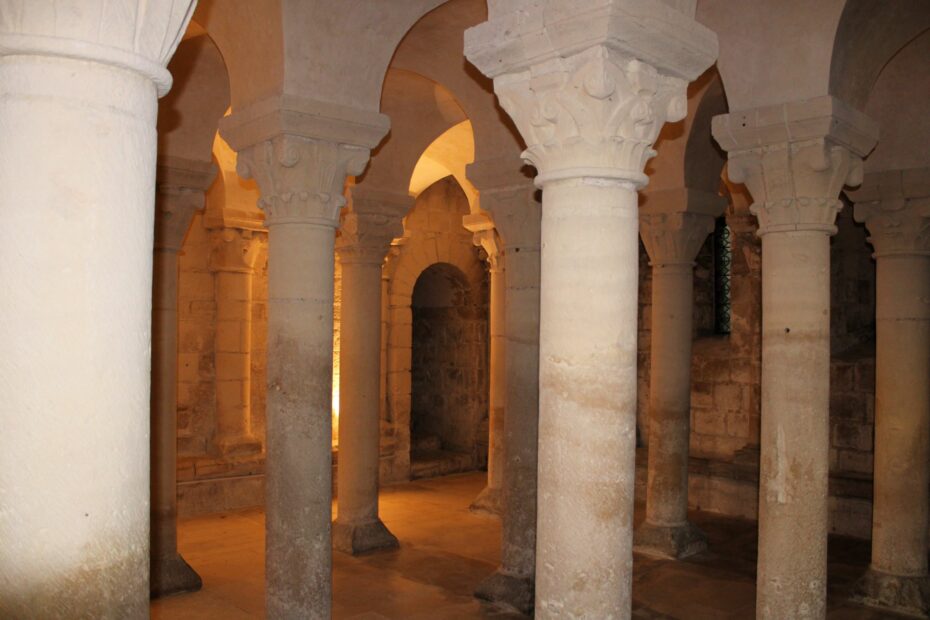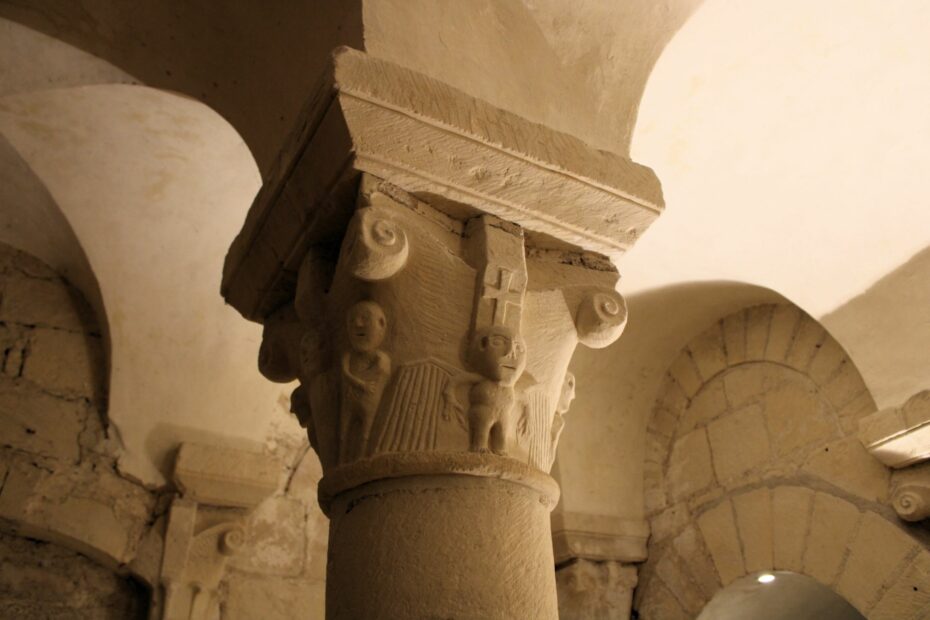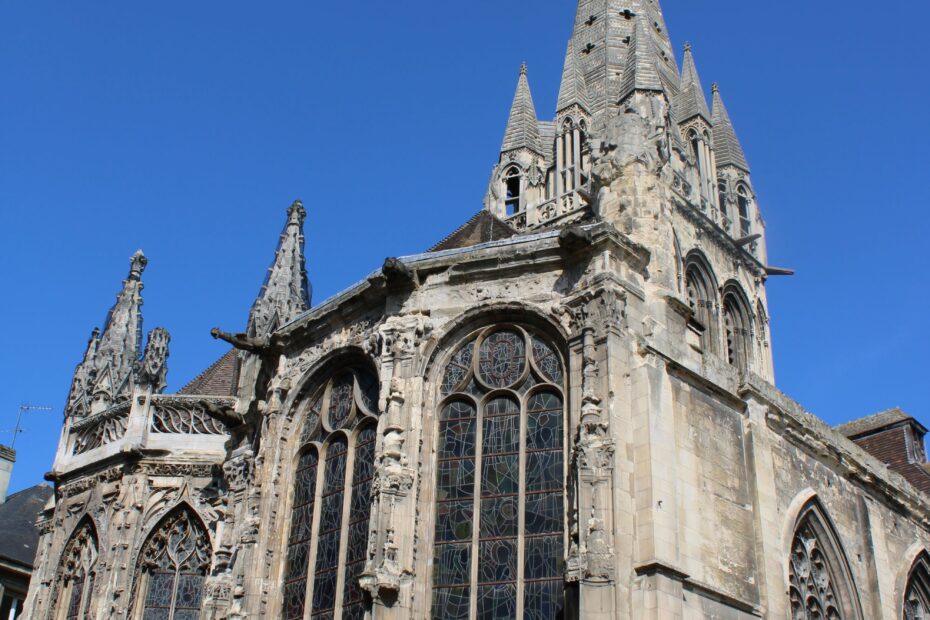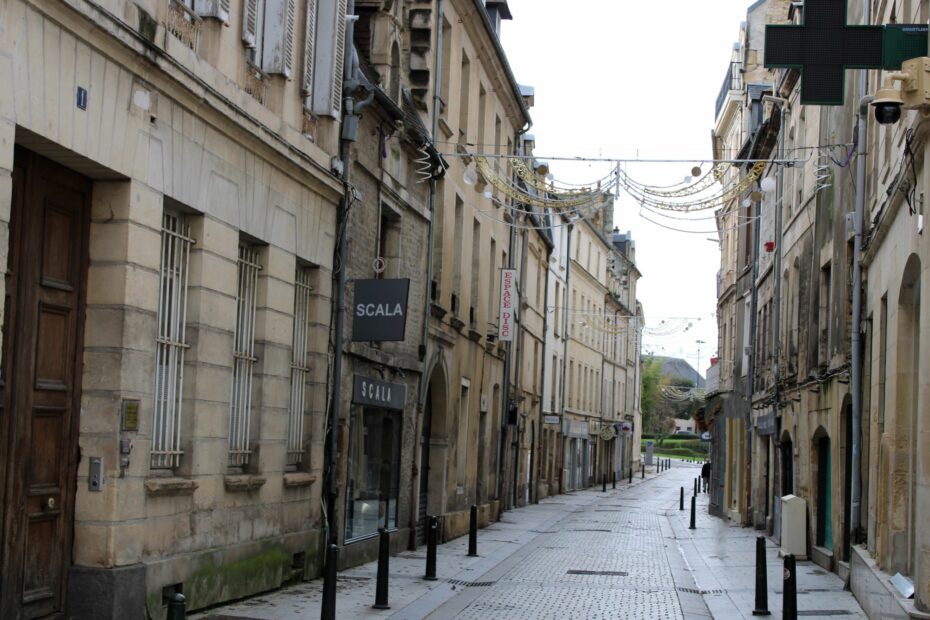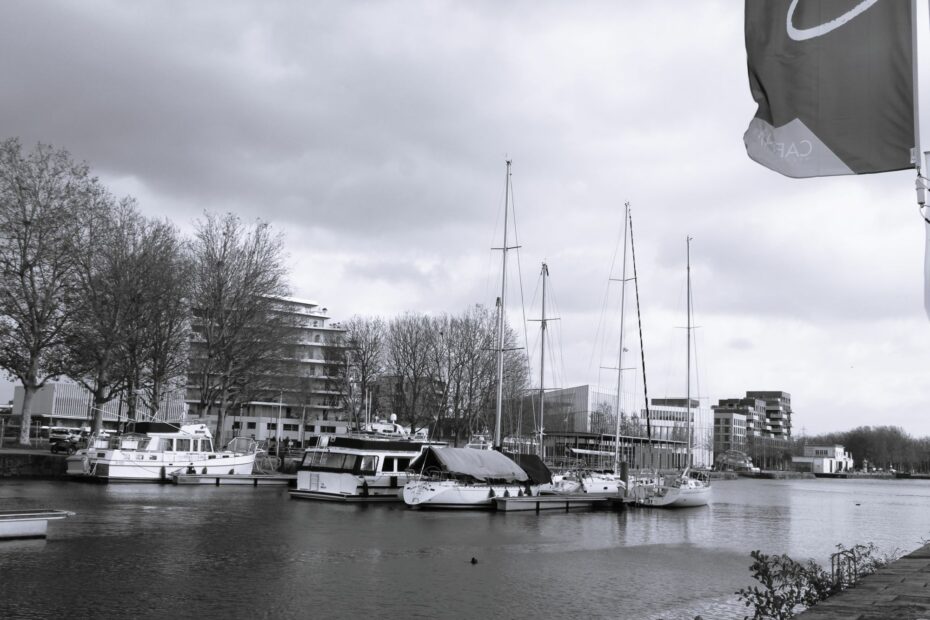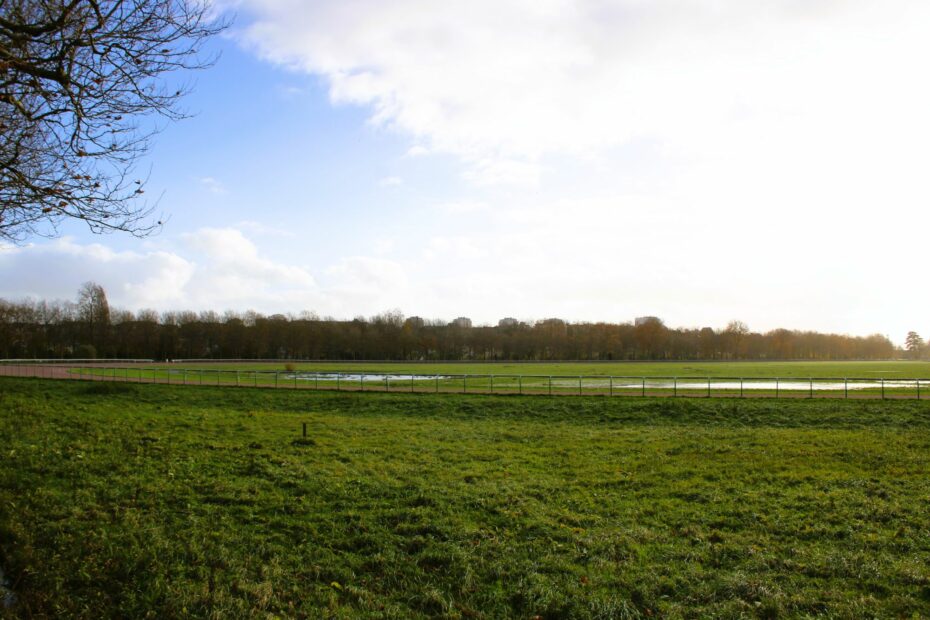THE CITY OF CAEN
CAEN, A RECONSTRUCTED CITY ...
- Caen is what is called a « reconstructed city » : its reconstruction and development plan after the war was entrusted to the architect-urbanist Marc Brillaud de Laujardière. The Reconstruction lasted from 1948 to 1963 and was an opportunity to rethink the design of the city around its old monuments to improve hygiene, make it more modern and practical, for example by widening the streets, ensuring running water for all…
- Caen stone was used for the reconstruction of buildings but it was a material already used since Antiquity. It’s a light stone with warm tones of a yellowish color, easy to work and sculpt. In the 11th century, it was widely used for the construction of many monuments in Normandy (the two abbeys and the castle of William the Conqueror for example) but also in England (the Tower of London, Westminster Abbey…). This is the starting point for its export. William the Conqueror having become king of England following the Battle of Hastings in 1066, it was a way for him to show and establish his power.
- The University was one of the first reconstructed buildings in the city after 9 years of work. It has been listed as a Historic Monument since 2012. An 8-meter high bronze statue representing a phoenix rising from its ashes (that you cannot fail to notice) was erected in the middle of the esplanade : a beautiful symbol since the university had been destroyed by fire during the war. Unfortunately, this phoenix is often mistreated by students during demonstrations : since its inauguration in 1958, it has been painted, plastered or wrapped at least a dozen times !

NOT TO MISS IN CAEN !
– Walk along the ramparts of the ducal castle to enjoy a view of the city and admire La Maison des Quatrans, rue de Geôle.
– At the foot of the castle, discover the charm of the old Vaugueux district with its cobbled street and restaurants and why not have lunch here ?
– Visit the two abbeys (including the interior of the city hall at the Men’s abbey).
– Stroll through the city center via Rue Froide (visit church Saint-Sauveur), Place Saint Sauveur, Rue Saint Pierre (admire the half-timbered houses at 52 and 54 street Saint-Pierre) and Rue Saint-Jean.
– Visit Church Saint-Pierre and church Saint-Jean (the leaning church).
– Go take a look at the greenhouse with exotic plants at the Botanical Garden (Jardin des Plantes).
– Walk around the marina and why not have lunch or dinner here ?
– Go to the weekly markets : on Friday mornings on Place Saint-Sauveur and on Sunday mornings in the marina district : both are big typically French and very lively markets !
– And of course, visit the Memorial Peace Museum (which is not in the town center).
PRACTICAL INFORMATION
OFFICE OF TOURISM OF CAEN
(close to the castle and Saint-Pierre church)
12 Place Saint-Pierre
14000 Caen
Ph : 02 31 27 14 14
Email : info@caenlamer-tourisme.fr
*
OPENING DAYS & HOURS
April, May, June and September
– Monday to Saturday : 9:30am-6:30pm (Tuesday from 10am)
– Sunday and public holidays : 9:30am-1:30pm.
Closed on May 1st.
July and August
– Monday to Saturday : 9am- 7pm
– Sunday and public holidays : 10am-1pm / 2pm-5pm.
From October to March
– Monday to Saturday : 9:30am-1pm / and 2pm-6pm.
– December 24th and 31st : 9:30am-1pm.
– Closed on Tuesday morning and Sunday.
– Closed on Jan 1st, Nov 1st, Nov 11th, Dec 25th.
**
2 Good Tips to explore Caen on your own !
GOOD TIP #1
WALKING TOURS
The Tourist Office offers 2 walking tours to discover the city by yourself with a map and explanations : the short tour lasts 2 hours and the long tour 3,5 hours.
Itineraries to be collected at the Office of Tourism.
Available in French, English, German, Italian, Spanish and Dutch.
A very good way to see the essentials of the city in complete freedom !
GOOD TIP #2
DIGITAL ROUTES
Explore Caen and its 1,000 years of history with your smartphone thanks to the free Wivi App created by the Office of Tourism of Caen-la Mer.
Many other itineraries are available between Caen and the seaside (Caen Summer 1944, Ouistreham at D-Day, Resort architecture in Hermanville-sur-Mer…).
In French and English.
Click HERE.
- When I go to Caen I often park :
– Fossés Saint-Julien where I can easily find space. It’s very close to the city center and not very expensive (parking meters).
– In Rue Saint-Jean : from the leaning church towards the Orne river (parking meters).
– Along the marina : you take a ticket and you pay for the time spent when you leave. - You can also opt for underground car parks :
– Car park of the City Hall right in the city center : 16 Place Guillouard, 14000 Caen.
– Car Park of the Castle (at the foot of the château) : 60 avenue de la Libération, 1400 Caen.
– Car Park at 1, Place de La Résistance (in the city center) 14000 Caen.
Traffic in Caen as in any city is quite busy so I advise you to park somewhere and then :
1- Explore the city on foot. You can follow the walking itineraries suggested by the Tourist Office (see above).
2- Or with a Velolib bicycle : a self-service bicycle sharing service available 24/7. There are 11 bike stations in the city center. Rent a bike for 1 euro per hour (payment by credit card directly on the terminals). Main downtown stations are located :
– at the Theatre : 53 Boulevard Maréchal leclerc.
– the City Hall : 1 Place Louis Gouillard.
– and 3 Place Bouchard : next to street Saint-Pierre.
– at the train station – Rives de l’Orne district : very convenient if you arrive by train for the day : Esplanade Léopold Sedar Senghor.
3- Eventually take the tram : it operates every day from 5:45am to 0:30am from Monday to Saturday and from 8:45am to 0:30am on Sunday.
Tram itineraries HERE.
A good value if you decide to visit several sites in a short time !
You can buy a 24, 48 or 72-hour City Pass Caen-La Mer with or without transports to discover many sites in Caen and on the coastline. You buy the City Pass and then you can access all the designated sites for free. You also get partners discounts (in shops, restaurants, leisure sites…)
To give you an idea, the following sites in Caen are included in the City Pass :
– Memorial Peace Museum
– Normandy Museum
– Fine Arts Museum
– Guided visit at the Women’s Abbey
– Entrance to the Men’s Abbey and city hall.
On the coastline (non-exhaustive list) : the following sites are related to WW2 :
– Grand Bunker and N°4 Commando museums in Ouistreham
– Merville Battery in Merville-Franceville
– Pegasus Bridge Museum
– Radar Station in Douvres la Délivrande.
You can buy your City Pass at the Office of Tourism of Caen and Ouistreham.
What to Visit ?
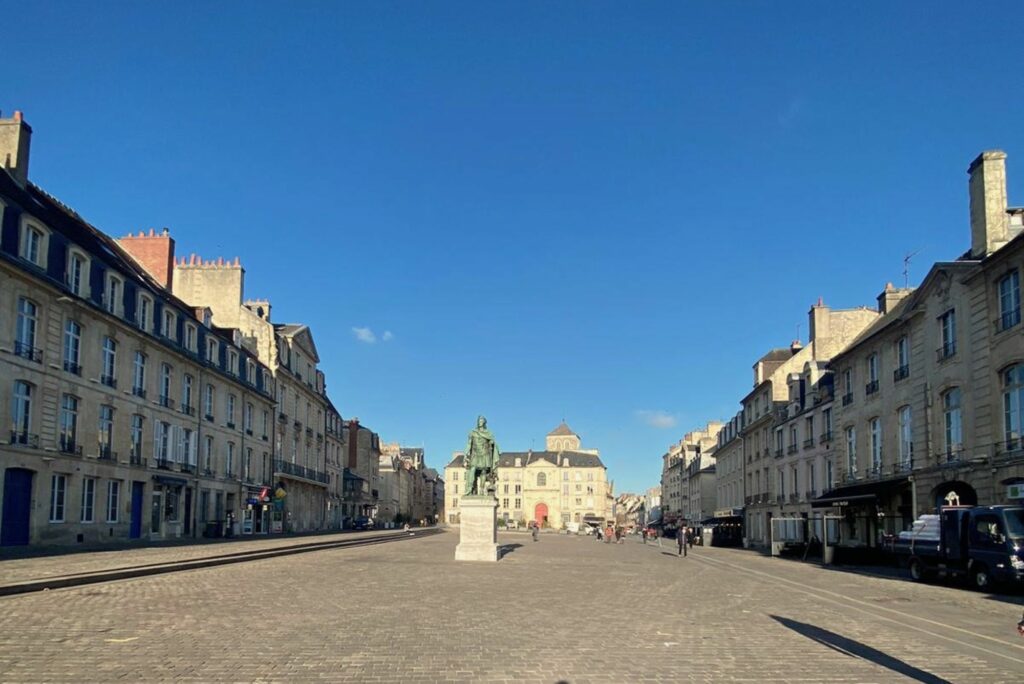

1- The Medieval Past of Caen : William’s castle, abbeys, historic streets, square and district, half-timbered houses, churches.
2- Other Places of Interest : marina, hippodrome, Rives de l’Orne shopping area, public gardens, weekly markets.
1- THE MEDIEVAL PAST OF CAEN
- The Castle of William the Conqueror
- The two abbeys founded by William and Matilda
- Other markers of the past in the city center
– Rue Froide
– Place Saint-Sauveur
– Half-timbered houses, Rue saint-Pierre and its side streets
– Churches
– The Vaugueux district
Did you know that Caen was a kind of Venice before ?
In the Middle Ages, Caen was crossed by the river Odon and that many of its waterways crossed the streets of the city.
We spoke at the time of the OdonS : there were the large river Odon (from the Men’s Abbey to the harbour) and the small Odon which ran along small streets such as Rue Froide, Rue aux Fromages… and the port extended to the heart of the city.
The «canals» of Caen led to big problems of insalubrity : they were used as wash houses, drains… and were of course real nests for plague and cholera. The Odon was therefore repeatedly channeled and diverted.
From 1933 to 1935, major remediation works radically changed the city’s landscape : Caen was one of the most polluted cities with tiphoid problems, so hygiene absolutely had to be improved. The « Odons » were covered or channeled. But this major project was very complicated because the water flowed under the houses. So many streets were completely renovated.
The neighborhood around Saint-Jean church is still called today the « Île Saint-Jean » (= Saint-Jean island), and we understand why since in the past it was surrounded by water. The canalized Odon river became underground in 1860 and the district lost its status as an island.
This also explains why the Saint-Jean church leans (there is water 1m40 deep under the church… ) and why some buildings in the neighborhood don’t have a cellar in the basement because of muddy soil.
THE CASTLE
A bit of history…
The Château de Caen was built around 1060 by William the Bastard, Duke of Normandy and future William the Conqueror, between his victory over the rebellious lords (at the battle of Val-ès-Dunes, 1047), his successes against other threats, and shortly before his conquest of England in 1066.
William, whose power was finally established from 1047, needed a stronghold to counterbalance the Norman capital of Rouen and assert its power in western Normandy.
He chose Caen, the rocky outcrop which dominates the Orne valley and controls the passageways. He built here his fortress, surrounded by stone walls on a vast area of five hectares. The castle dominated the town. Caen became the favourite residence for the dukes of Normandy and kings of England and also a place of power.
The castle today
Access to the ramparts and the castle walls are free and open all the time. Entrance fees for museums only.
Since March 2023 and until 2025, major works of redevelopment of the site are carried out within the walls of the castle but the museums remain open.
Walk around the ramparts and you will have a beautiful panorama of the city.
Apart from the ramparts, few elements from the Middle Ages have been preserved except the Exchequer’s room and Saint-George church, both dating from the 12th century.
- The Exchequer’s room was built by William’s son, Henri I Beauclerc at the beginning of the 12th century : it was a reception and residence hall where the Duke held large solemn assemblies. It was also used as a court of auditors and justice.
– 3D visit of the Exchequer’s room HERE.
- In the 1870s, the castle was transformed into a barracks and remained so until 1940. The buildings built to house the troops were then razed . The intensive bombardments of 1944 did not damage the remaining buildings too much.
- Today, the site houses the Normandy Museum in the Palace of Governors and the Fine Arts Museum. See below section « Museums ».
In 2010, Saint-George church became the reception and information centre of the site where you can see models, 3D reconstitutions and multimedia animation recounting the castle’s history.
– 3D visit of the church HERE.
THE TWO ABBEYS FOUNDED BY WILLIAM AND MATILDA
1- ABBAYE AUX HOMMES
The Men’s Abbey was founded by William the Conqueror in 1063 and was consecrated in 1077 under the name of Saint-Etienne abbey.
Today, the beautiful monastic buildings dating from the 18th century, the cloister, magnificent panelled rooms decorated with paintings house the town hall of Caen and the abbey the tomb of William (dead in 1087). 
This abbey inspired many English churches built after the Conquest of England in 1066.
After many disasters, the monks of Saint-Maur took over the Abbey at the end of the 17th century, and decided to rebuild all the abbey buildings.
Preserved from bombing in 1944 because it was used as a health shelter for the locals, the Abbaye-aux-Hommes became the Town Hall of Caen in 1965. I advise you to visit it, it’s absolutely beautiful.
VISIT OF THE CITY HALL OF CAEN : Information HERE.
- You can access and visit for free Saint-Etienne Abbey where William is buried every day from 9am to 6pm (on Sunday 2pm-6pm).
- Self-guided tour of the City Hall (cloister, panelled rooms, Guards’ room…) and temporary exhibitions : all opening days/times HERE.
- Guided tours of the City Hall in English only in July and August :
– Monday to Friday : at 11am, 1:30pm and 4pm.
Abbaye aux Hommes (Men’s Abbey)
Esplanade Jean-Marie Louvel
14000 Caen
abbayeauxhommes@caen.fr

2- ABBAYE AUX DAMES
The Ladies‘s Abbey was founded by Queen Matilda of Flanders, William’s wife in 1060. It was consecrated in June 1066 and dedicated to the Holy Trinity.
In November 1083, Queen Matilda was buried there under a slab of black marble from Tournai.
Since 2016, the abbey has been the headquarters of the Normandy Region.
The Ladies’ Abbey consists of two parts : the Trinity Church which is a masterpiece of Norman Romanesque art and the convent buildings.
The abbey church was built between 1060 and 1080. It was reorganized in the 12th century, restored in the 19th century and it underwent a cleaning in the early 1990s.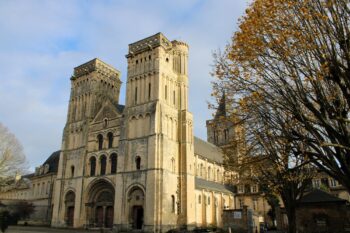
This Benedictine abbey was home to a community of nuns until the French Revolution. Then the convent’s buildings gradually deteriorated until they were entirely rebuilt in the 18th century on the decision of the abbess Madame Froulé de Tessé. But because of financial difficulties, it took almost 100 years to build the whole site which was never finished since the fourth wall of the cloister was never built. The current convent buildings that you can see date from the 18th century.
The abbey became successively a military garrison (1793-1909), a Hôtel-Dieu (hospital) in 1823 and a care-home in 1908. The last nuns of the Hospice Saint-Louis care-home and their patients remained on the site until 1984. Then the Regional Council of Lower Normandy settled there after two years of renovation.
VISIT OF THE LADIES’ ABBEY : Information HERE.
- You can access and visit for free the Trinity abbey church where Matilda is buried, every day :
– 8:30am-12:30pm & 1:30pm-6pm from Monday to Friday.
– 2pm-6pm on Saturday and Sunday.
– Closed on January 1st, May 1st and December 25th.
– Admire the beautiful 18th century fresco that decorates the choir vault and depicting the Assumption as well as the choir itself illuminated.
– Don’t miss to go down in the superb crypt dating from the 11th century and note the carved capitals of the columns mainly decorated with plant ornaments except one at the entrance representing the Last Judgement with the Archangel Saint-Michael welcoming the dead. - Self-guided tour of the cloister and the exterior of the abbey convent buildings and d’Ornano park :
– Monday to Friday : 8:30am-12:30pm and 1:30pm-6pm.
– Saturday, Sunday and public holidays : 2pm-6pm. - Guided tours (only in French/guided tour in English only for groups under reservation) with a small fee of the old convent buildings, the abbey church and its crypt :
– Duration : around 1 hour.
– Monday to Friday : at 2:30pm.
– Saturday, Sunday and public holidays : at 2:30pm and 4pm.
– Closed on January 1st, May 1st and December 25th.
Abbaye aux Dames (Women’s Abbey)
Place Reine Mathilde
14000 Caen
abbayeauxdames@normandie.fr
And go for a walk in Michel d’Ornano park !
This is the park of the abbey created in the 18th century. It was inaugurated in 1992 to be dedicated to a local figure, Michel d’Ornano who was the President of the Lower Normandy Regional Council from 1983 to 1986.
A beautiful French park of six hectares to walk and enjoy a breathtaking view of Caen and its many steeples from the Lebanon cedar planted in 1849.
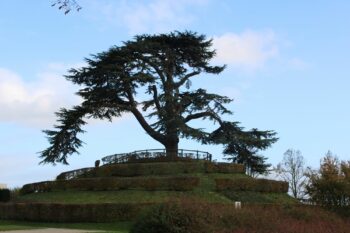 Michel d’Ornano Park
Michel d’Ornano Park
Abbaye aux Dames
Boulevard Georges Clémenceau
14000 Caen
Open every day 8am-6:30pm (until 8pm from April to October). Free access.
OTHER MARKERS OF THE PAST IN THE CITY CENTER
1- RUE FROIDE (= Cold Street)
– A beautiful narrow pedestrian street that has kept the charm of the past with its many small craft shops, bookstores… but also its old facades, the central drain and its cobblestones. The buildings lining the street date back to various eras and represent each architectural current from 1450 to 1800.
– If you pushed the doors, you would discover behind these old facades inner courtyards and bourgeois residences.
Rue Froide is known to be one of the oldest streets of Caen.
It would have been created around the 7th century by Saint-Regnobert, bishop of Bayeux, at the same time as the parish of Notre-Dame de Froide-Rue and its church (where today Saint-Sauveur church is in Rue Froide). But its existence cannot be not proven until the 12th century because of a lack of written and archaeological sources. This street is mentioned for the first time in the 12th century, around 1120.
Located close to the former university created in 1432 (which was in the street now called Rue Pasteur), the Cold Street became the printers’ street from the 15th century.
During the Revolution, it became Rue du Commerce with boutiques and luxury crafts such as glassmakers, furniture makers, gilders….
Notice particularly the following places and elements :
– at n° 16 : you can observe the oldest porch of the street opening onto the old house of the Senses, famous master glassmakers of the 16th century.
– at n° 41 : a 15th century manor house modified in the 17th century.
– at n° 33 and 35 : the two dormer windows show the transition from Gothic to Renaissance.
But why the « Cold Street » ?
In fact, the origin of its name remains a mystery and one can only make assumptions such as :
– The street is exposed to cold winds by its orientation (a logical explanation)
– Cold Street would take its name from words pronounced by Queen Matilda (« Oh! The cold street » ), while her husband William, after a violent anger, made her walk all over the city, her hair tied to a horse ! Is it a legend or the truth, we don’t know…
SAINT-SAUVEUR CHURCH in Rue Froide (dating from the 14th, 15th and 16th centuries)
There is nothing left of the original Romanesque church that would date from the 7th century or the one from the 12th century.
During the Revolution, the thirteen parishes of Caen were reduced to seven. That of Notre-Dame-de-Froide-Rue disappeared. The building became a store for army crews.
Then in 1803, the parish of Notre-Dame-de-Froide-Rue was restored under the name of Saint-Sauveur church.
This church deserves a visit because its two adjacent naves are a rather rare feature that is not often observed in churches in France.
2- PLACE SAINT-SAUVEUR
Not far from the Rue Froide, Place Saint-Sauveur (Saint-Sauveur Square) is one of the oldest public squares in downtown Caen since the Middle Ages.

This is where a very pleasant weekly market takes place every Friday morning (not to be missed !). In fact, from 1027, a market was already held on this square every Monday and Friday, so it is not a new tradition.
The square served various functions over time:
– A pillory and a public execution site. In 1548, the old wooden pillory was replaced by a stone scaffold, which was later destroyed in 1696. The pyre was situated in front of the church portal.
– It was the courthouse district. Between 1783 and 1792, the Courthouse of Caen was constructed at the end of the square.
– During the 18th and 19th centuries, students enrolled at the nearby former university (located in the district of the current rue Pasteur, which was destroyed in 1944) were accommodated in the surrounding buildings. Saint-Sauveur Square was where they gathered for recreation and engaged in social and political debates.

Around the square, admire the very beautiful private mansions such as Hôtel Fouet at n°20 dating from 1740 or Hôtel Marescot de Prémare (at the corner of the square and street Pémagnie) at n°10 dating from the second half of the 18th century. Both are listed as Historic Monuments.

3- HALF-TIMBERED HOUSES IN THE CITY CENTER, RUE SAINT-PIERRE AND SIDE STREETS
Rue Saint-Pierre is one of the main shopping streets of the city center that starts from the Saint-Pierre church and leads to rue Ecuyère and rue Arcisse de Caumont and then to the former Courthouse and the city hall (Men’s Abbey).
In street Saint-Pierre (which is one of the main shopping streets of Caen), you cannot miss the two very beautiful half-timbered houses all renovated that date from the 15th century. You will find them at n° 52 and 54.

The end of Rue Saint-Pierre splits into two streets : Rue Arcisse de Caumont and Rue Ecuyère, known for their abundance of bars and vibrant nightlife. Rue Ecuyère is affectionately dubbed the « thirsty street, » boasting not only bars but also charming antique and décor shops, along with beautifully preserved old facades.
Just before reaching Rue Ecuyère, take a right onto the quaint old alley, Rue Vauquelin and observe at number 23 a stunning building with a tower dating back to the 17th century (currently housing the Medicis pizzeria).
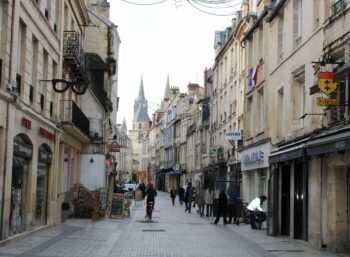
Make sure to check out the sculpted facade at 9 Rue Ecuyère, right across from La Tour Solidor bar. It got a makeover in 2023 and looks beautiful !

Afterward, head down the quaint old Rue aux Fromages (= the cheese street) in front of number 9, which will lead you to Place Saint-Sauveur. This narrow street was once known as Goes-up-with-regret Street because it was the final path for those condemned to death before their execution at Place Saint-Sauveur.

Another notable half-timbered house stands on Rue de Geôle at the foot of the castle (you can enjoy a fine view of it from the ramparts) : La Maison des Quatrans. Constructed around 1460, it remained in private hands until 1944 when it suffered severe damage during the bombing of the Battle of Normandy.

From 1953 to 1998, it served as the headquarters for the administration of historical monuments, and later as the Regional Directorate of Cultural Affairs. However, over time, the building became increasingly unsuitable for its purpose. Today, it is home to several cultural associations.
4- INTERESTING CHURCHES IN THE CITY CENTER
Saint-Pierre Church
The construction of the Gothic Saint-Pierre church in Caen stone that we know today began in the 13th century but we know from excavations that took place in the 19th century that two monuments preceded the current church : the first, pre-Romanesque, remains unknown ; the second, Roman, still has some elements in the nave.
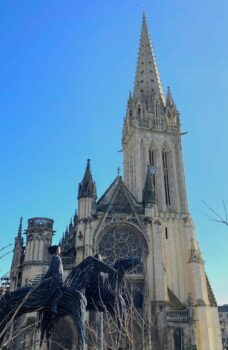
Its construction lasted from the 13th until the 16th century which explains the presence of several styles : radiant Gothic in the western facade, flamboyant Gothic in the nave and the choir, Renaissance in the apse…
This magnificent Renaissance-style carved apse rebuilt on stilts in the first half of the 16th century, was surrounded by the small Odon River until 1848. Poets and romantics found the vision of these abundant Italian-style sculptures reflecting in the water very inspiring and beautiful ! However, the insalubrity of the water that was used for everything (wash-house, sewage…) and bad smells led the mayor of the time, François Gabriel Bertrand to undertake work to cover the Odon river in 1848 after having razed the houses that surrounded the church.
If you go to the Museum of Fine Arts which is located within the ramparts of the castle, you will see an oil on canvas by the English painter William Fowler named « Vue de l’Eglise Saint-Pierre de Caen » (= View of Saint-Peter church of Caen) showing the church and its surroundings painted in 1841 before the sanitation works.
And below is an engraving of the church as it appeared before 1848, which I have at home. It’s quite surprising to see how different it looks compared to today.

In the 14th century, the Gothic bell tower and its imposing stone spire were built and were considered «the king of the bell towers of Normandy» : a masterpiece of architecture which influenced other monuments.
During the Revolution, the church was transformed into a Temple of Reason, revolutionaries wanting to suppress the Catholic Church. But in 1801, it became again a place of Catholic worship.
In June and July 1944, the district of the church was hard hit by Allied bombings : the spire of its bell tower and its roof were destroyed. The spire was rebuilt identically in 1957.
In the 20th and 21st centuries, many restoration works took place. For instance, the stained glass windows which had been all destroyed during WW2, were replaced by modern creations around 1960.
I advise you to enter the church and admire the two consecutive vaults that show two different periods of construction.
Saint-Pierre church of Caen has been listed as a Historical Monument since 1840.
Saint-Pierre church of Caen
Place Saint-Pierre
14000 Caen
Open every day all year round :
Free for all.
– Monday-Friday : 7:15am-7:30pm
– Saturday & Sunday : 9:30a-7:30pm
Saint-Jean Church, the leaning church
The oldest parts of Saint-Jean church date from the 14th century (like Saint-Pierre church). It was built at the same time as the creation of the Saint-Jean district, the richest district of the city where many aristocrats lived. It is known that another building of which nothing remains today was erected in the 12th century at the same place. There could even be traces of the 7th century of a possible pre-Romanesque church.

During the 14th century, this area was an island, with the church encircled by the Odon river and its tributaries, now flowing underground. Consequently, the soil was unstable, and workers observed the building leaning even during its construction.
Despite efforts made over the centuries to prevent the situation from worsening, the church continues to lean and likely always will! It’s our Norman version of the Leaning Tower of Pisa… During the French Revolution, Saint-Jean church served as a saltpeter storage facility, then it was restored for Catholic worship in 1802.
In 1944, it sustained significant damage during the bombing, and restoration efforts concluded in 1969. Regular reinforcement and consolidation work are ongoing. Nevertheless, it’s open for worship, and you can visit without any concerns. Once inside, take note of the choir which is longer than the nave, a rather uncommon feature.
Saint-Jean church
110 rue Saint-Jean
14000 Caen
Open all year round :
Free for all.
Can be visited at the following hours :
– 9am-12pm & 2pm-6pm.
– Closed on Saturday morning and Sunday.
5- THE VAUGUEUX DISTRICT, a medieval district at the foot of the castle

The Vaugueux is an old district of Caen dating from the Middle Ages and well-known today for its few cobbled streets at the foot of the castle.
It is worth seeing because it has a lot of charm with its old and beautiful half-timbered and stone houses but above all that’s where the restaurants line up next to each other ! However, it’s beautiful. Stroll through the few pedestrian streets of the district and observe the beautiful facades and dare to venture into the small narrow lanes. You will quickly go around if you don’t eat there. But it’s also a good place to have lunch before or after visiting the castle since the Vaugueux is very close. The area is very lively in the evening and at night, so why not dine there ? You will find good restaurants for all budgets.
What does mean « Vaugueux« ?
Several assumptions over time were made.
The inscription «Val des Gueux» (= the Valley of Beggars) engraved at the corner of rue du Vaugueux and rue Porte au Berger indicates the name that was given in the Middle Ages to this poor district of the city.
Vaugueux might also come from the Latin «valliculus» which means « small valley ». This « valley » could have been one of the suburbs of the city at the time of William the Conqueror.
History of the district
Have you noticed the church perched on a promontory and which seems to dominate the neighborhood ? This is the Church of the Sepulcher founded in 1219 and overlooking the castle. The district of the Vaugueux began to develop from the foundation of this church and all around it. However, this district already existed before : the first mention of it dates back to the late 11th century/ early 12th century. The Vaugueux became a suburb of Caen around 1070. At that time, Caen was surrounded by fortifications and there were six gates to enter the city one of which was located in this neighbourhood : the « Porte au Berger » (= the gate of the shepherd). Indeed, the Vaugueux was a strategic crossroads since two important roads (the one to Douvres-la-Délivrande and the one to Dives-sur-Mer) left from this gate.
Until 1750, when the gate closed at nightfall, travelers could find there taverns and rooms to spend the night.
In the 19th century, the Vaugueux looked a lot like the district of the Middle Ages except that the streets were reorganized and widened around to facilitate the traffic that had become complicated in the street of the Porte du Berger because of its narrowness.
But living conditions were unsanitary and unhealthy and the district was severely affected several times by cholera epidemics in the second half of the 19th century. Moreover, because of its drinking establishments and prostitutes, the neighborhood had a very bad reputation. It was then that charitable institutions were created to help the most deprived.
Did you know that Edith Piaf’s grandparents ran a bar on « Rue Porte au Berger » in the Vaugueux district at the beginning of the 20th century ?
In June and July 1944, the Vaugueux was bombed by the Allies several times.
During the Reconstruction of the city, the landscape of the district was modified (widening of streets, clearing the view of the castle…) and it was in 1980 that the streets of Vaugueux and Porte du Berger became pedestrian and that the district an attractive place for locals and tourists thanks to its pretty renovated old facades and its many restaurants of all kinds.

I advise you to walk up to the Church of the Sepulcher (above rue du Vaugueux) even if it is not open to the visit because the place is beautiful.
Eglise du Sépulcre
5, place du Sépulcre
14000 Caen.
2- OTHER PLACES OF INTEREST
THE MARINA DISTRICT
The marina area is very lively in the evening and you will find many bars and restaurants: a good place to go out at night !
On your way from Saint-Pierre church to the marina, notice an old tower : the « Tour Leroy » . If you don’t look, you can pass by without paying attention ! It is a remain of the city’s medieval fortifications.

The « Leroy tower » (also called « William the King Tower ») was probably erected in the 14th century : at that time, it faced another tower, the « Tour aux Landais » which does not exist any more today. These two towers were used to protect access to the port which was closed at night by a chain suspended in between. As I have already explained, there were streams all over the city and although it is difficult to think of this disappeared landscape, the port was well at the foot of this tower.
The Tour Leroy is closed to the public so you cannot visit it. It has three levels and a platform at its top.
We know that this tower was in the past a prison and then a house for the guardian of the covered market that stood between Saint-Pierre church and the tower from 1882 and 1959.
Origin of the Saint-Pierre basin (the current marina)
The current Saint-Pierre basin is the result of the widening of the section of the Odon river before it flows into the Orne river which itself flows into the Channel Sea. The Orne river was particularly difficult to navigate because of its numerous meanders, narrowness and natural siltation linked to the tide.
Many development projects were proposed in the 17th and 18th centuries, but none was successful, because of technical difficulties. But shipping from Caen becoming very complicated and difficult, it was finally decided in 1837 to build a 14-km long canal linking Caen to Ouistreham and create a basin fed by the Odon and the Orne rivers.
It took 20 years to build the Caen canal which was finally inaugurated on August, 23rd 1857.
During the following decades, the canal was constantly improved, expanded and deepened, due to the increase in traffic and its growing use.
Every Sunday morning, there is a large market along the marina, not to be missed if you are in Caen ! Very typical and French !
MY GOOD TIP !
Follow this interesting hiking route to discover the port district and traces of the industrial past of the city in the Presqu’île de Caen (= Peninsula of Caen).
A walking-guide/bookelt has been created by members of the Citizen Ward Council to discover the area all around the harbour.
It is available only in French. However, if you don’t understand French, you can easily follow the suggested itinerary on the map (page 3) and look at the pictures which will give you an idea of the district over time.
A new district has emerged for a few years on the Peninsula of Caen where the library Alexis de Tocqueville is. It’s called La Presqu’île de Caen.
You will discover in this area the industrial past of the city : with the creation of the canal, several industrial activities were established on this strip of land : activities in the transport, trading of coal, wood and building materials and the export of iron ore. These activities gradually disappeared during the second half of the 20th century. At the beginning of the 21st century, the Peninsula was transformed to accommodate cultural and apartment buildings with modern architecture.
You will certainly notice the Cargö and the Dôme, two modern buildings to the right of the Peninsula : Le Cargö is a contemporary music performance hall inaugurated in 2007 and Le Dôme is a center of scientific, technical and industrial culture that opened in 2016.
Click HERE to get the walking-guide.
This a one-hour walking itinerary
(3 kms/1.86 miles).
Stop for a drink or for a very good lunch during your walk at the bar-restaurant Au Quai des Brumes , 60 avenue Pierre Berthelot, 14000 Caen, located at the end of the peninsula.
A 1930s decor with many references to the industrial past of the area. Really worth !
– Open from Monday to Friday, 8:30am-8pm.
– Ph : 02 31 52 08 83
– Reservation is recommended to eat. Excellent traditional cuisine.
– Not expensive.
– A place frequented by the locals and unknown by tourists. Typically French, a full immersion !
Want to eat in another good restaurant on the Peninsula of Caen ?
– Le Raphaël restaurant overlooking the port : a refined brasserie by the waterfront with a large shaded terrace : 7 Quai François Mitterrand 14000 Caen.
– Koboon, serving refined Thai street food cuisine : 47 Quai François Mitterrand, 14000 Caen.
– Bertine, a creperie offering excellent galettes and crepes with a twist, showcasing local products (flour from nearby mills) : 2 rue de Suède et de norvège, 14000 Caen.
THE HIPPODROME, LA PRAIRIE AND LES RIVES DE L' ORNE SHOPPING AREA.
LA PRAIRIE DE CAEN AND THE HIPPODROME
La Prairie is a 90-hectare green space in the center of the city. The term of « Prairie » appeared for the first time in 1027. It’s a main element of the historical and natural heritage of the city. Besides being a racecourse, it is also a sensitive natural area protected since 1932 : 242 plant species have been listed so far. It’s also an ornithological reserve where many species regularly stay : since 1972, 180 species of birds have been observed.
Over time, the space was developed and transformed : in the 11th century, canals were dug to drain the marshes, the Prairie being a large mowing meadow ; paths were also created for the hay wagons to pass.
At the end of the 17th century, tree-lined public walks were built.
The first horse race took place on August 26, 1837 and on February 13, 1839, the city council decided to create a permanent racecourse. Today, over 30 horse races are held there every year.
The present boundaries of the Prairie were established after the Second World War. The rubble of the buildings destroyed during the Battle of Caen was used to drain the marshes ; new boulevards and avenues were created and the course of the river Odon was diverted.
The Prairie plays a key role in flood management of the Orne river since it serves as a reservoir during major floods and then turns into a large pond.
You can walk around the Prairie, it’s a 3-km loop (1.86 miles) much appreciated by runners and walkers ! You are surrounded by nature while being very close to the city center.
LES RIVES DE L’ ORNE SHOPPING AREA
A new shopping and leisure area (but also with offices and housing) located on the banks of the Orne river and behind the train station that was inaugurated in 2013.
– It is not of great tourist interest but you can shop there (there are shops that you will not find in the city center : H&M, Adidas, Desigual, Mango, NewYorker, Jennyfer…).
– You will also find a large cinema (Pathé Rives de l’Orne) with 10 movie theaters, 6 of which have 3D.
– Convenient since located next to the train station to eat a bite before taking the train. There are several kinds of restaurants.

Les Rives de l’Orne
Quai Amelin, 14000 Caen
Underground car park.
MY GOOD TIP IN THIS AREA !
Come and sail in the city center from the nautical base located next to the Rives de l’Orne shopping center !
From April to October, rent a paddle, canoe, kayak, electric or pedal boat and discover Caen differently along the Orne river !
Several options are proposed : rental from 1 hour to 5 hours. 
Au Fil de l’Orne water sports center
10 Quai Hamelin, 14000 Caen
– Open from April to October
– Every day from 11am until 7pm during French school holidays and public holidays.
– On Wednesday, Saturday and Sunday outside school holidays.
– Opening times can vary according to weather conditions.
– More info : aufildelorne.fr
and on Facebook.com/aufildelorne
PUBLIC GARDENS
1- JARDIN DES PLANTES (botanical garden)
The botanical garden of Caen is about 10 minutes walk from the city center (rue Froide) and a very nice place to admire more than 8000 species of Norman and exotic plants on an area of 3.5 hectares. 
This very pleasant public garden was created in 1736 on the old quarries of Caen stone. It was at first a university garden for schools of Medicine and Pharmacy. After the French Revolution it expanded and became a botanical and public park. Two large greenhouses were built in 1860 as well as the orangery and in 1891, the botanical institute.
This garden was classified as a Historic Monument in 1942.
Don’t miss the beautiful exotic greenhouses open every day from 1pm to 5pm.
Children’s play areas and picnic tables.

From late May to early October, come and have a drink and/or lunch at the Orangerie tea-room and restaurant : a very pleasant atmosphere away from the bustle of the city center where you will enjoy delicious healthy local cuisine with reasonable prices.
Brunch on Saturday and Sunday.
Opening hours :
Late May-August : 10am-7pm
September-early Otober : 10am-6pm.

Jardin des Plantes de Caen (Botanical Garden of Caen)
Place Blot, 14000 Caen
– Open every day, free access, from 8am (Monday-Friday) and 10am on weekends and public holidays.
– Closes at 7:30p from May 1 to August 31 (please check online for the other times of the year).
– Closed on December 25th and January 1st.

2- LA COLLINE AUX OISEAUX (not in the city center)
This landscaped floral park called the Bird Hill inaugurated in 1994 is located northwest of the city close to the Memorial Peace Museum of Caen. It was created on a former hill of trash : in 1923, the city bought this land to create a landfill. For fifty years, the city’s garbage was thrown there, gradually forming two hills of 35 and 25 meters. It was in 1973, that the municipality decided to transform this space that was no longer used into a park.
I advise you if you have time to go for a walk in this beautiful 17-hectare green space the day you visit the Memorial Museum.
Stroll and discover the several themed gardens of the park and don’t miss above all the rose garden with 15,000 roses including varieties from the Middle Ages to nowadays.
You will also enjoy a beautiful panorama of the city more than 80-meters high.
But why the Bird Hill ?
At the time when the place was a landfill, it attracted birds and especially gulls. Hence its name.
La Colline aux Oiseaux
Avenue Amiral Mountbatten, 14000 Caen.
Free admission, free parking.
Opening :
– Monday to Friday : from 8am.
– Weekends and public holidays : from 10am.
– Closes at 8:30pm from May 1st to August 31st.
– Closed on December 25th and January 1st.
Picnic areas, mini-golf, fast-food restaurants, children’s play areas… Pets prohibited.
THE WEEKLY MARKETS
There are two very pleasant weekly markets in the city center of Caen that are unmissable on Friday and Sunday morning. Markets in France are part of our culture !
– FRIDAY MORNING : Place Saint-Sauveur, on the beautiful oldest square of Caen : a very charming market !
Fresh and local products and also several second-hand clothing dealers at very attractive prices (1 or 2 euros).
– SUNDAY MORNING : along the marina to the Leroy Tower. It’s the most important market in the area : local products, craftsmen, new and second-hand clothes… Take away dishes of all kinds (couscous, galettes, pizzas, Chinese food..).
A typical French market to see if you are in Caen on Sunday morning!
Museums
There are three museums in Caen.
In my opinion, the Memorial Peace Museum is unmissable but is not located in the city center.
The two others are within the castle walls so in the city center and are very interesting to visit as well if you can stay in Caen for more than a day.
THE NORMANDY MUSEUM (within the castle walls)
Duration of visit : 1hr to 1hr30.
This museum located in the Logis des Gouverneurs (the Governor’s residence) opened to the public in 1963. You will learn here about the history of Normandy and the material and cultural evolution of its population from Prehistoric times until the 20th century. Over 80,000 historical artifacts are preserved in the museum.
Musée de Normandie
Château de Caen
14000 Caen
– Open every day except on Monday outside July and August.
– Closed on January 1st, May 1st, Ascension Thursday, November 1st and December 25th.
– Small entrance fee.
– Free admission under 26 and for everyone, every first weekend of the month.
** If you want to visit also the Fine Arts Museum, I advise you to opt for the Museo Pass which is a good value for money ! **
THE FINE ARTS MUSEUM (within the castle walls)
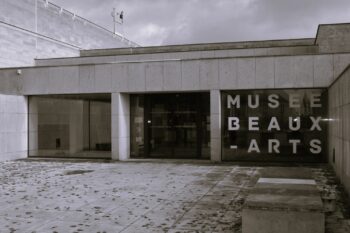
Duration of visit : about 1hr30-2 hours.
The Fine Arts Museum of Caen is one of the most important in France for European paintings of the 16th and 17th centuries and also boasts an exceptional collection of engravings. So if you like art, I absolutely recommend it!
You will also find contemporary pieces.
For information, the Museum of Fine Arts of Caen was founded in 1801 and was at the time located in the former Eudist seminary of Caen on the current Place de la République (then called Place Royale). But it was completely destroyed in 1944. Rebuilt from 1967 within the castle walls, the new museum was inaugurated in December 1970.
Musée des Beaux Arts de Caen
Le Château, 14000 Caen
– Open 7/7 in July and August (Weekdays : 9:30am-12:30pm & 1:30pm-6pm / Weekends : 11am-6pm)
– Outside July & August : open from Tuesday to Sunday : 9:30am-12:30pm & 1:30pm-6pm.
– Closed on January 1st, Easter Sunday, May 1st, Ascension Thursday, November 1st and December 25th.
– Closing at 4pm on December 24th and 31st.
– Small entrance fee.
– Free admission under 26 and for everyone, every first Sunday of the month.
** If you want to visit also the Normandy Museum, I advise you to opt for the Museo Pass **
THE MEMORIAL PEACE MUSEUM

Duration of visit : 2-4 hours.
– I advise you to visit the Caen Memorial early in the morning when it opens (especially during the peak tourist season) when it is less crowded.
– Buy your tickets online to save time.
The Memorial Peace Museum of Caen is dedicated to the history of the 20th century and peace and in particular to the Second World War and the Battle of Normandy. It is located on the site of a former German blockhouse.
It was inaugurated on June 6, 1988 by President François Mitterrand for the 44th D-Day anniversary.
My opinion : a museum very educational for all ages, with many period documents, objects, videos… You can spend a long time here without realizing it as the museum is well made and interesting ! Really worth a visit.
The museum is divided into several sections :
– Second World War
– The D-Day landing and the Battle of Normandy
– The former command post of the German General Richter located under the Memorial (the underground bunker)
– The Cold War
– A 360° film on 11 screens of 19 minutes « Europe, Our History » to plunge into the 20th century and understand History.
– A permanent exhibition of more than 100 photographies by the reporter and photographer Patrick Chauvel who covered more than 50 years of conflicts. This exhibition is free of charge.
– Outside : the Souvenir Gardens : three gardens were created to pay tribute to the Allied soldiers who fought and died in Normandy : you will find the American Garden (1994), the Canadian Garden (1995) and the British Garden (2004). Free access to the gardens.
– Temporary exhibitions are regularly organized.
And…
– You can have lunch at the snack-bar Le Bistrot du Mémorial within the museum.
– There is a large bookstore specialized on the history of the 20th century and WW2 : unique in Normandy.
Le Mémorial de Caen
Website : memorial-caen.fr
Esplanade Général Einsenhower
14050 Caen
– Open 7/7 from February to October. Check online for the other months as there is a weekly closing day that changes according to the season.
– 9am-7pm from April to September (9am-6pm the rest of the year)
– CLOSED ON JUNE 6, 2024.
– Entrance fees : full rate, child rate (10-18), family pass, senior rate (over 65), combined tickets with Arromanches 360 Circular cinema and/or Falaise Memorial.
– Audioguide App with a small extra cost.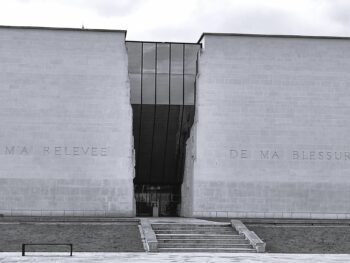
My Selection of Restaurants in Caen
TRADITIONAL RESTAURANTS / BRASSERIES
L' Assiette au Beurre (close to the university and the castle)
– 4 rue Léon Lecornu, 14000 Caen.
– Ph : 09 86 49 20 35
– Open from Monday to Friday for lunch & dinner and one Saturday evening per month.
– Website (Facebook) HERE.
A « rotisserie bistro » where you will enjoy very good homemade traditional dishes in a neighborhood restaurant atmosphere.
Terrace on sunny days.
Daily special (for lunch) : 22 euros 3 courses or 18 euros 2 courses : a good value for money !
Close to the university, not far from the Vaugueux district but not right in the city center.
La Poterne (Vaugueux district)
– 9 rue du Vaugueux, 1400 Caen
– Ph : 02 31 93 57 46
– Open 7/7 for lunch and dinner (open very late !)
– Website (Facebook) HERE.
Dining rooms with beams and stones and a fireplace… the charm of yesteryear in this institution of Caen ! Good traditional cuisine in a beautiful setting in an old district.
Concerts are held on some Friday evenings. I love their piano bar nights !
En Voiture Simone (close to the theatre)
– 17 rue de l’Oratoire, 14000 Caen
– Ph : 02 31 50 19 94
– Open for lunch from Tuesday to Saturday and also for dinner on Thursday, Friday and Saturday.
– Website HERE.
A girly restaurant (it’s all pink !) like an indoor garden offering healthy cooking prepared with fresh and local products.
Lunch menu changes every day ; in the evening, it’s only tapas.
This restaurant has a chic flea-market spirit and it’s very nice. A little piece of sweetness in Caen !
Le Carlotta (along the marina)
– 16 Quai Vendeuvre, 14000 Caen.
– Ph : 02 31 86 68 99
– Open every day except on Sunday, for lunch and dinner.
– Website HERE.
An art-deco brasserie well known to the locals offering tasty and generous traditional cuisine.
Le Raphaël (on the Peninsula of Caen)
– 7 rue de Suède et de Norvège, 14000 Caen
– Ph : 02 58 47 03 00
– Open every day for lunch and dinner except on Sunday and Monday.
– Website HERE.
Large bay windows overlooking the port, a beautiful roof terrace and another outdoor terrace under plane trees at the water’s edge… A very beautiful setting ! An elegant modern dining room in a refined style to taste good fresh and seasonal Norman products.
Daily menus at 24 (3 courses) and 19,50 euros (2 courses).
Au Quai des Brumes (on the Peninsula of Caen)
– 60 Avenue Pierre Berthelot, 14000 Caen
– Ph : 02 31 52 08 83
– Open from Monday to Friday, 8:30am-7pm. Bar and lunch only.
Located at the end of the peninsula, this traditional bar-restaurant is a bit out of time and welcomes all kinds of rather local clients. So if you want an authentic place where you can enjoy a very good homemade food for lunch, try it ! The team is very welcoming and you will have a great time. You can also stop there just for a drink.
Reservation recommended.
Very reasonable prices. Daily special and menu 2 or 3 courses.
PIZZERIAS & CREPERIES
- Pizzerias
Canaglia (historic city center)
– 5 rue Ecuyère, 14000 Caen
– Ph : 02 31 79 90 83
– Open 7/7 for lunch and dinner.
– Website HERE.
Beautiful and very good pizzas with a well ventilated dough, it’s so good ! A choice of original recipes such as pizzas with a cream of zucchini or beetroot. A delight !
Restaurant located in the historic center.
Pizza Rustica - Chez Pino (historic city center)
– 19 rue Froide, 14000 Caen
– Ph : 02 31 86 50 50
– Open from Tuesday to Saturday for lunch and dinner.
– Website HERE.
A very good pizzeria (and also an Italian restaurant) well-known to the locals since 1987 with a beautiful inner courtyard where you can enjoy your meal on sunny days.
Located in the historic center.
Abracadabra (Vaugueux district)
– 4 rue du Vaugueux, 14000 Caen
– Ph : 02 31 43 71 38
– Open from Tuesday to Saturday for lunch and dinner.
– Website (Facebook) HERE.
If you want to eat a good hearty pizza in the Vaugueux district, you will be at the right address ! My favorite pizza here is the Tandoori one : tomatoes, mozarella, tandoori chicken, potatoes, onions, lemon, garlic, parsley, chilli and oregano… just thinking about it, I want to go back ! In addition, the prices are very correct.
- Crêperies
Le Grenier à Crêpes (city center)
– 182 rue Saint-Jean, 14000 Caen
– Ph : 02 31 83 79 44
– Open from Tuesday to Saturday for lunch and dinner.
– Website HERE.
Very good buckwheat pancakes and crepes made with local products, beautiful decor, very friendly welcome, a good value, what more? A great creperie downtown !
Sacrée Mathilde (Vaugueux district)
– 3ter rue du Vaugueux, 14000 Caen
– Ph : 02 31 39 64 92
– Open from Tuesday to Saturday for lunch and dinner.
– Website HERE.
A nice creperie offering a choice of buckwheat pancakes with modern and original recipes. Excellent !
Reservation recommended.
Bistronomic restaurants
Une Cuillère Carrée (close to the marina)
– 22 rue de Bernières, 14000 Caen
– Ph : 02 31 08 80 51
– Open for lunch ( from Thursday to Saturday) and for dinner (from Tuesday to Saturday).
– Website HERE.
A bistronomic restaurant offering tasty and refined French cuisine with Italian flavors at very reasonable prices.
Dishes are always prepared with care with quality, fresh and seasonal products.
Service and atmosphere are friendly.
A great restaurant !
La Véranda (city center)
– 30, rue du Général Giraud, 14000 Caen
– Ph : 02 50 28 08 91
– Open from Tuesday to Saturday for lunch & dinner.
– Website (Facebook) HERE.
A bistro atmosphere for this bistronomic traditional restaurant located in a quiet side street of the city center where the locals like to eat ! Original flavors with fresh and seasonal products. A beautiful discovery.
Terrace.
Full menu (lunch & dinner) at 29,50 euros (starter-main course-dessert) / lunchtime : 21,50 euros (2 courses) or full menu.
Gourmet restaurants
Magma (city center)
– 24 rue Saint-Manvieu, 14000 Caen
– Ph : 02 50 53 69 86
– Open from Tuesday to Saturday for lunch and dinner
– Website HERE.
Olivier Barbarin is a renowned Chef who has already been awarded a one-Michelin star from 2010 to 2015.
Although he is from Auvergne (a region in the center of France), he fell in love with the Normandy terroir 12 years ago and opened his first gourmet restaurant in Caen in 2022.
His cuisine is modern, surprising, subtle, full of colors and a real treat for the tastebuds !
Lunch menus are very affordable : 22 and 26 euros for 2 or 3 courses and 41 euros, 4 courses.
Other menus for dinner with 5 and 7 courses.
It’s a beautiful culinary experience !
Stéphane Carbone (close to the marina)
– 14 rue de Courtonne, 14000 Caen
– Ph : 02 31 28 36 60
– Open for lunch and dinner from Tuesday to Friday and only for dinner on Saturday.
– Website HERE.
Chef Stéphane Carbone was starred in the Michelin Guide from 2006 to 2019.
You will eat in a beautiful elegant setting overlooking the glazed kitchen where you can see the cooks at work. There is a patio, heated in winter. The atmosphere is friendly, not snobbish.
Refined and excellent cuisine, an explosion of flavours on the palate ! A perfect service. It’s a beautiful culinary journey. A gourmet restaurant that lives up to its reputation.
Lunch menus at 30 and 35 euros with 2 or 3 courses. Other options for lunch and dinner.
Take-away meals also available.
Foreign Flavors
Ô Globe (5 minutes walk from the Men's abbey)
– 11 rue Caponière, 14000 Caen
– Ph : 02 31 30 57 47
– Open from Tuesday to Saturday for lunch & dinner
An excellent small restaurant to travel all around the world ! O Globe offers dishes inspired by specialties from everywhere. And it’s a success ! Beautiful presentation of dishes and delicious flavours. A true culinary gem.
Daily special for lunch from Tuesday to Friday : 19 euros 2 courses / 24 euros 3 courses.
One of my favorite restaurants in Caen !
Benazir (Indian restaurant)
– 45 avenue du 6 juin, 14000 Caen (close to the Orne river)
– Ph : 02 31 84 54 53
– Open 7/7 for lunch & dinner.
– Website HERE.
If you’re like me and love Indian cuisine, then try this Indian and Pakistani restaurant which is my favorite in Caen.
Lunch menus at 12 ( main course + dessert) ,15 or 18 euros (3 courses) / Thali at 15 euros : during the week only.
A good value !
Sasésu (Bo buns, pho soups, Vietnamese food)
– 156 rue Saint-Jean, 14000 Caen (city center)
– Ph : 02 31 91 83 43
– Open 7/7 11am-11:30pm
– Website HERE.
A simple but very good and cheap restaurant offering Vietnamese dishes to eat on site or take away.
I love their Bo Buns (less than 10 euros) !
Le Bistrot Basque (along the marina)
– 26 Quai Vendeuvre, 14000 Caen
– Ph : 02 31 38 21 26
– Open for lunch and dinner from Monday to Saturday.
– Website HERE.
Warm atmosphere, nice decoration that makes travel, a very nice terrace and good food Basque and Spanish specialties and tapas. Tasty and quality cuisine, hearty dishes.
A very good address facing the harbour.
Koboon (a Thai restaurant on the Presqu'île, along the marina)
– 47 Quai François Mitterrand, 14000 Caen
– Ph : 02 61 92 15 05
– Open everyday (lunch & dinner) except on Sunday and open on Monday only for dinner.
– Website HERE.
An excellent street food restaurant ! The specialties are prepared on the flame of woks… as in Bangkok. The menu is varied with authentic specialties and prices are very affordable ! And you are very well welcomed by a young team.
One of my favorite restaurants in Caen !
TEA-ROOMS & small catering
Les Dunes (historic center)
– 30 rue Arcisse de Caumont, 14000 Caen.
– Ph : 02 31 79 60 43
– Restaurant open from Tuesday to Saturday : 12pm-2:30pm.
– Tea-room open from Wednesday to Saturday : 2:30pm-5:30pm.
– Website (Instagram) HERE.
A lovely family restaurant with a charming terrace on sunny days well hidden in a green and flowery courtyard at the back (you would never imagine it like that just passing by) : it’s one of the most beautiful summer terraces in the city center according to me ! And of course, the food is delicious : the dishes and cakes are homemade, generous, colorful and tasty. A quiet and very pleasant place in the heart of the city !
Gloriette Concept Store (historic center)
– 16 rue Saint-Laurent, 14000 Caen
– Ph : 02 31 08 30 00
– Open from Tuesday to Saturday :
– Coffee shop (and store) open from 10am to 7pm.
– Lunch from 12pm to 3pm.
– Website HERE.
A unique concept for this place which is at the same time a clothing and designer furniture store and a coffee shop-restaurant. The place is original, natural and relaxing.
Stop there during the day for a drink (cold or hot: coffee specialties, hot chocolate, tea …) with a good homemade pastry. The chocolate cake and brownies are delicious.
Prices are moderate.
Memoranda café and bookshop (historic center)
– 19 rue des Croisiers, 14000 Caen
– Open from Tuesday to Friday (10:30am-1pm -2:30pm-7pm) and on Saturday (2:30pm-7pm).
– Website HERE.
Everybody knows Memoranda in Caen ! Located at the corner of Rue des Croisiers and Rue Froide, it’s a true institution in the city : you will find here a multitude of second-hand books for all tastes in an old and authentic decor. Just the visit is worth entering ! And the icing on the cake, upstairs, there are delicious pastries and small tables in the middle of rows of books: the only problem is to be able to find a place to sit because this bookshop-café is very popular with the locals and there is not much space ! But I advise you to try anyway…
Moon & Sons (tea-room, vegan food and pub next to the castle and the Vaugueux)
– 20 avenue de la Libération, 14000 Caen
– Ph : 02 31 74 05 01
– Open every day except on Monday from 11 or 12 or 3pm. Please check opening times online.
– Follow them on Facebook HERE.
By pushing the door of this pub, you enter the world of magic actually! Here, in the afternoon you can have a good snack with a hot drink with children (or without…) and in the evening eat pub food ( 100% vegan) with a large choice of beers and cocktails.
You will certainly love the very successful atmosphere !
No booking up to 5 people.
Where to stay in Caen ?
HOTEL FRANCOIS D'O (historic center)
A small comfortable 2-star hotel very well located in a quiet old street of the historic center.
4 rue des Cordeliers, 14000 Caen
Ph : 02 31 86 37 15
Bookable directly HERE or via Booking.com
The hotel is located in a building dating from the 18th century and was fully renovated.
– Very warm welcome from the hosts
– 17 clean bedrooms nicely decorated and spacious spread over 3 floors (no lift).
– Lovely indoor courtyard/garden
– An excellent value for money in the city center !
HOTEL LA FONTAINE CAEN CENTRE (historic center)
A very well located 2-star family run hotel of 13 rooms right in the city center.
26 rue de la Fontaine, 14000 Caen
Ph : 02 31 85 31 70
Bookable directly HERE or via Booking.com
The hotel is located in a street next to Place de la République and a large paid parking.
– 13 renovated rooms (11 double and 2 family rooms for 4 people) all with Queen size beds.
– Very good breakfast
– The team can also arrange private tours to the D-Day beaches from the hotel, shuttle to Mont Saint-Michel…
– A good value for money for a stay in Caen city center.
THE PEOPLE CAEN (on the Peninsula) : a hotel and a youth hostel.
A new concept of hotel/bar/restaurant offering comfortable private or shared rooms, dormitories and shared living spaces : between the youth hostel and the hotel !
15 Avenue Victor Hugo, 14000 Caen
Ph : 02 61 53 69 40
Bookable directly HERE or via Booking.com
– Located on the Presqu’île (= Caen Peninsula, the new district that emerged opposite the marina), 10 minutes on foot from the city center.
– Private rooms, dormitories for groups of 6 or 8 people, shared dormitories (male and female), a shared lounge, a terrace, a restaurant and a bar.
– Very clean, well equipped, welcoming staff and friendly atmosphere. Quiet rooms.
– Cheap : a good option for young people but not only !







